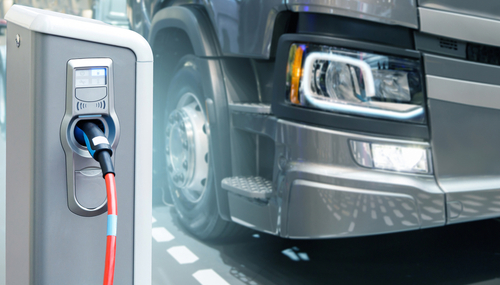Biden administration lays out strategy for zero-emission trucking infrastructure

The Biden-Harris administration introduced a new strategy for the deployment of zero-emission medium- and heavy-duty vehicle (ZE-MHDV) charging and hydrogen fueling infrastructure.
The National Zero-Emission Freight Corridor Strategy targets public investment to amplify private sector momentum, focus utility and regulatory energy planning, align industry activity, and improve air quality in local communities heavily impacted by diesel emissions.
“For over a century, petroleum-fueled freight has transported vital food and resources to American families but at the same time, these vehicles have also contributed to lower public health, especially in densely populated communities,” U.S. Secretary of Energy Jennifer Granholm said. “The Biden-Harris Administration is addressing this issue head-on with innovative strategies to transform freight so it not only supports American families and businesses, but also protects the environment for future generations.”
The strategy, in place from 2024 to 2040, was developed by the Joint Office of Energy and Transportation and U.S. Department of Energy (DOE), in collaboration with the Department of Transportation (DOT) and the Environmental Protection Agency (EPA). It will be implemented in four phases:
• Establish priority hubs based on freight volumes (2024-2027).
• Connect hubs along critical freight corridors (2027-2030).
• Expand corridor connections initiating network development (2030-2035).
• Achieve national network by linking regional corridors for ubiquitous access (2035-2040).
“This is a big move to deliver environmental justice – 75% of heavy truck traffic travels on just 4% of our nation’s roads, jeopardizing the health of our most vulnerable communities,” National Climate Advisor Ali Zaidi said. “President Biden’s historic investments in zero-emission infrastructure on those high-traffic roads and the hubs they connect will rapidly transform freight transport in the U.S. and strengthen American innovation.”
In alignment with the Joint Office’s National Zero-Emission Freight Corridor Strategy, the Federal Highway Administration is announcing the designation of National EV Freight Corridors along the National Highway Freight Network and other key roadways. The designations are a critical part of the Administration’s strategy for building out a convenient, reliable, national EV charging network that supports individual drivers and commercial needs.
Since Biden took office, the number of publicly available EV chargers nationwide has increased by more than 80 percent to more than 173,000. Further, at least 40 U.S.-based facilities to produce EV chargers have been announced or opened. Biden’s Investing in America agenda has attracted more than $25 billion of investment in the U.S. EV charging network. These freight corridor designations are expected to crowd in even more investment for EV charging, with a particular focus on the needs of medium- and heavy-duty vehicles.
Deployment factors include corridor segment usage by freight volume, port usage by annual freight tonnage, projected ZE-MHDV volumes, disproportionate environmental and air quality burden from MHDV transportation and non-attainment for criteria air pollutants, states with ZEV deployment-enabling policies, and “on the ground” planning through DOE’s commercial ZEV corridor planning grants.
